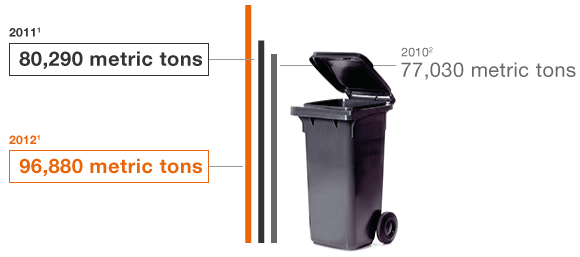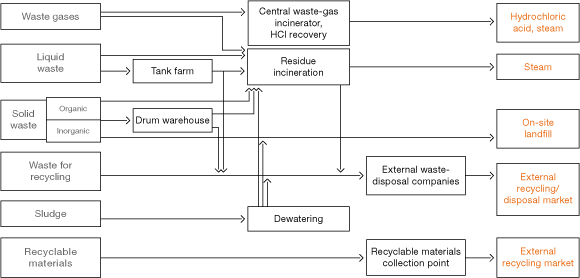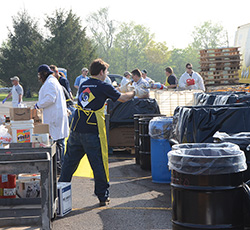Waste
Recycled Waste

1 Including the silicon-metal plant in Holla, Norway
2 Excluding the silicon-metal plant in Holla, Norway
In integrated production, we minimize waste by feeding byproducts back into the production loop. WACKER endeavors to avoid waste throughout a product’s entire life cycle.
In 2012, we recycled 96,880 metric tons of waste, a year-on-year rise of over 20 percent (2011: 80,290 metric tons). Disposable waste has been reduced, since the filter cake from wastewater treatment in Burghausen is now being recycled instead of being disposed of as before.
In Burghausen, waste that previously had to be disposed of as hazardous waste has been supplied to cement factories as fuel since 2011. Thanks to this measure, we emit around 1,400 metric tons of CO2 less per year.
Due to its high silicon dioxide content, dewatered pyrogenic silica sludge from the hazardous-waste incinerator can also be used as an additive in cement production and as a landfill construction material. In 2012, our Burghausen plant supplied around 2,800 metric tons (2011: 3,550 metric tons) of this sludge to a cement factory and recycled 4,500 metric tons (2011: 3,850 metric tons) as landfill construction material.
In 2012, we recovered around 8,300 metric tons (2011: 5,100 metric tons) of dewatered mineral sludge for external use as a landfill construction material. In addition, we turned 2,650 metric tons of dewatered mineral sludge into backfill material and used it at our own Stetten salt mine. Prior to 2010, such material would have been destined for a hazardous-waste disposal site. Our new approach cuts down on the use of more valuable construction aggregates and backfill material. In the future, we plan to recover most of the sludge for use in landfills and as backfill.
Groupwide, we record the volume of hazardous waste we generate according to two criteria: “to be recycled” and “to be disposed of.” Currently, we do not have figures relating to the export of waste for the entire Group, but we can say that no hazardous waste is exported from our Burghausen site.
The following diagram depicts how we recycle or dispose of waste and waste gas at our Burghausen site.
Waste and Waste-Gas Disposal at the Burghausen Site

| Download XLS |
|
Waste | ||||||||||
|
|
|
|
| |||||||
|
t |
20121 |
20111 |
20102 | |||||||
| ||||||||||
|
|
|
|
| |||||||
|
Total |
136,800 |
127,700 |
125,550 | |||||||
|
Of which |
|
|
| |||||||
|
Disposed of |
39,920 |
47,410 |
48,520 | |||||||
|
Recycled |
96,880 |
80,290 |
77,030 | |||||||
|
Or |
|
|
| |||||||
|
Hazardous |
73,620 |
68,230 |
69,320 | |||||||
|
Non-hazardous |
63,180 |
59,470 |
56,230 | |||||||
Preventing Packaging and Transport Waste
WACKER is keen to minimize the environmental impact of its packaging materials. For instance, our Siltronic division prefers reusable packaging such as the Hybox. Some 50 percent of 300 mm wafers from Burghausen, Freiberg and Singapore are shipped in this type of reusable container, which is designed for transportation in hygienically sensitive areas. Each Hybox shipped saves us 50 kilograms in packaging material. Since 2006, these reusable containers have saved us over 1,245 metric tons of waste overall. Although we still ship most of our smaller silicon wafers in disposable packaging, we have replaced the protective inner layer of foamed plastic with sustainably sourced cardboard.
Initiatives against Waste
We maintain a chemicals-exchange database. Burghausen site employees can use it to identify surplus substances, either in opened packaging drums, or in their original container. The database is a practical way to coordinate the recycling of surplus materials.
USA: Hazardous-Waste Day for Neighbors

Adrian site employees invite their neighbors to bring in their hazardous waste for recycling each spring.
WACKER held its 14th “Household Hazardous Waste Day” for neighbors of its Adrian, Michigan site in spring 2011. On this day, neighbors from Lenawee county can bring in anything not allowed in trash cans, like oil and (latex) paints, flammable liquids, waste oil, antifreeze, insect repellents, spray cans, alkaline and mercury batteries, fluorescent tubes and incandescent lamps. Held since 1997, this campaign run by employee volunteers has resulted in the collection of some 115 metric tons of hazardous waste at Adrian. Since 2012, we’ve been conducting this campaign in collaboration with another chemical company from the region, trading off with them as a venue every other year.